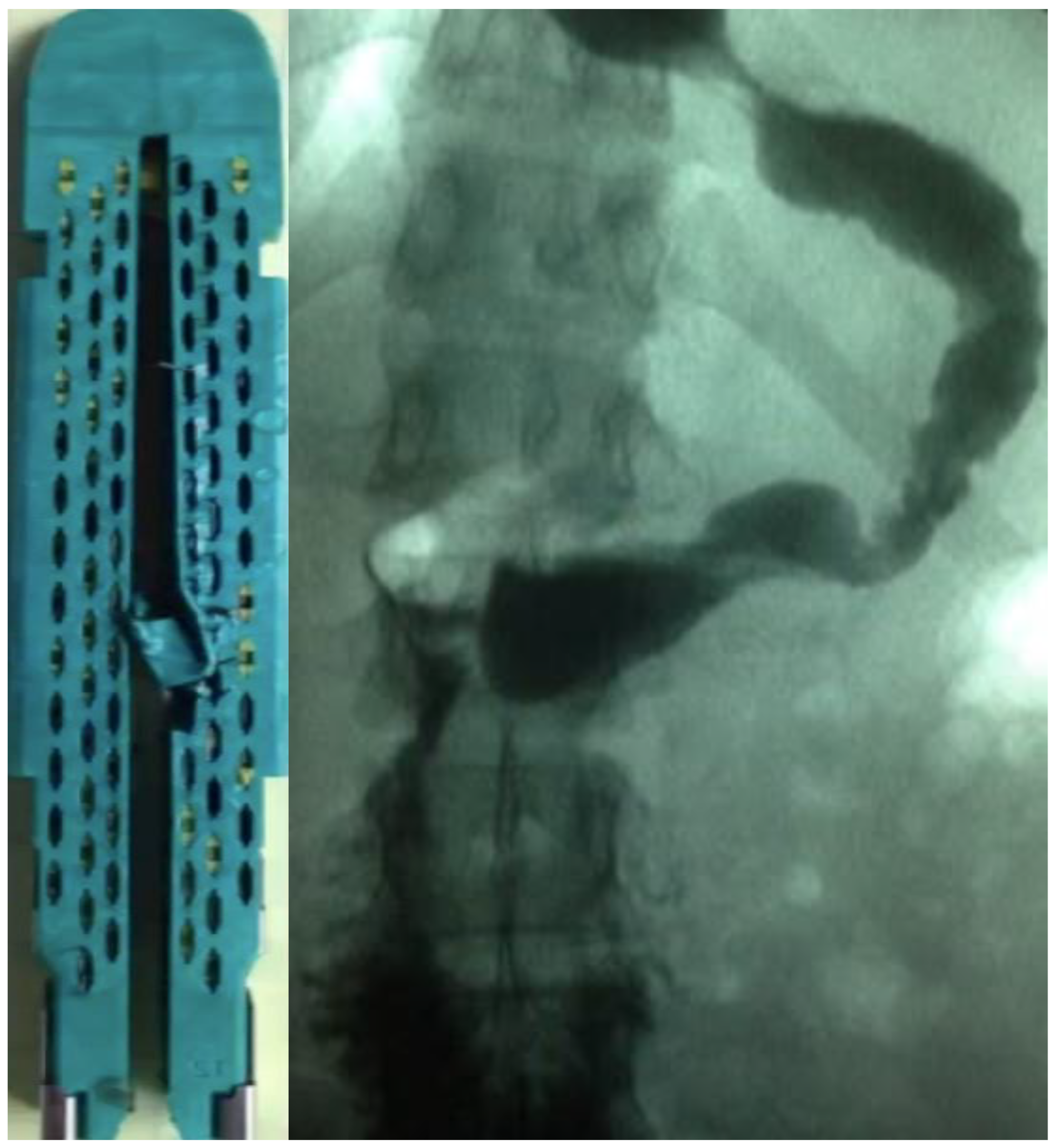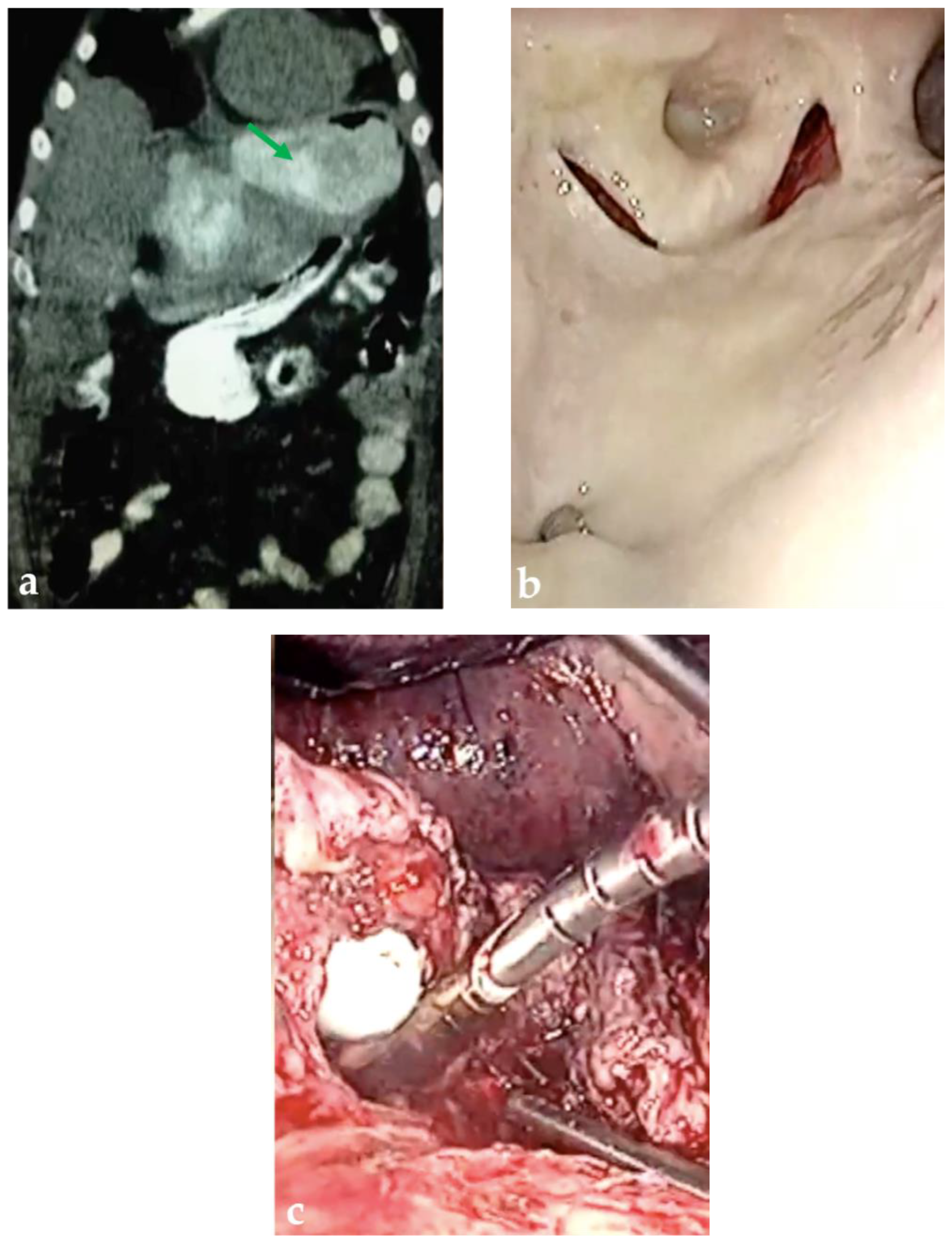Successful Management of Gastric Leakage Post Gastric Sleeve by Gastric Bypass Conversion
Abstract
1. Introduction
2. Detailed Case Description
3. Discussion
4. Conclusions
Author Contributions
Funding
Institutional Review Board Statement
Informed Consent Statement
Data Availability Statement
Conflicts of Interest
Appendix A
References
- Díaz-González, B.V.; Bautista-Castaño, I.; Hernández García, E.; Cornejo Torre, J.; Hernández Hernández, J.R.; Serra-Majem, L. Bariatric Surgery: An Opportunity to Improve Quality of Life and Healthy Habits. Nutrients 2024, 16, 1466. [Google Scholar] [CrossRef] [PubMed]
- Trujillo-Garrido, N.; Santi-Cano, M.J. Motivation and Limiting Factors for Adherence to Weight Loss Interventions among Patients with Obesity in Primary Care. Nutrients 2022, 14, 2928. [Google Scholar] [CrossRef] [PubMed]
- Palermo, M.; Nedelcu, M. Complications in Bariatric Surgery. J. Laparoendosc. Adv. Surg. Technol. 2021, 31, 139–140. [Google Scholar] [CrossRef] [PubMed]
- Arterburn, D.E.; Telem, D.A.; Kushner, R.F.; Courcoulas, A.P. Benefits and Risks of Bariatric Surgery in Adults. JAMA 2020, 324, 879. [Google Scholar] [CrossRef] [PubMed]
- Rogers, A.M. Current State of Bariatric Surgery: Procedures, Data, and Patient Management. Technol. Vasc. Interv. Radiol. 2020, 23, 100654. [Google Scholar] [CrossRef]
- Lim, R.; Beekley, A.; Johnson, D.C.; Davis, K.A. Early and late complications of bariatric operation. Trauma Surg. Acute Care Open 2018, 3, e000219. [Google Scholar] [CrossRef]
- Pêgo-Fernandes, P.M.; Bibas, B.J.; Deboni, M. Obesity: The greatest epidemic of the 21st century? Sao Paulo Med. J. 2011, 129, 283–284. [Google Scholar] [CrossRef]
- Arrieta, F.; Pedro-Botet, J. Reconocer la obesidad como enfermedad: Todo un reto. Rev. Clin. Esp. 2021, 221, 544–546. [Google Scholar] [CrossRef]
- Blüher, M. Obesity: Global epidemiology and pathogenesis. Nat. Rev. Endocrinol. 2019, 15, 288–298. [Google Scholar] [CrossRef]
- Soroceanu, R.P.; Timofte, D.V.; Danila, R.; Timofeiov, S.; Livadariu, R.; Miler, A.A.; Ciuntu, B.M.; Drugus, D.; Checherita, L.E.; Drochioi, I.C.; et al. The Impact of Bariatric Surgery on Quality of Life in Patients with Obesity. J. Clin. Med. 2023, 12, 4225. [Google Scholar] [CrossRef]
- Raza, M.M.; Njdeaka-Kevin, T.; Polo, J.; Azimuddin, K. Long-Term Outcomes of Bariatric Surgery: A Systematic Review. Cureus 2023, 15, e39638. [Google Scholar] [CrossRef] [PubMed]
- Praveenraj, P.; Gomes, R.M.; Kumar, S.; Senthilnathan, P.; Parthasarathi, R.; Rajapandian, S.; Palanivelu, C. Management of gastric leaks after laparoscopic sleeve gastrectomy for morbid obesity: A tertiary care experience and design of a management algorithm. J. Minim. Access Surg. 2016, 12, 342. [Google Scholar] [CrossRef] [PubMed]
- Hamdan, K.; Somers, S.; Chand, M. Management of late postoperative complications of bariatric surgery. Br. J. Surg. 2011, 98, 1345–1355. [Google Scholar] [CrossRef] [PubMed]
- Ghosh, S.K.; Roy, S.; Chekan, E.; Fegelman, E.J. A Narrative of Intraoperative Staple Line Leaks and Bleeds During Bariatric Surgery. Obes. Surg. 2016, 26, 1601–1606. [Google Scholar] [CrossRef] [PubMed]
- Li, M.; Zeng, N.; Liu, Y.; Sun, X.; Yang, W.; Liu, Y.; Mao, Z.; Yao, Q.; Zhao, X.; Liang, H.; et al. Management and outcomes of gastric leak after sleeve gastrectomy: Results from the 2010–2020 national registry. Chin. Med. J. 2023, 136, 1967–1976. [Google Scholar] [CrossRef] [PubMed]
- Soto, F.C. Sleeve Gastrectomy Leaks: The Way, we Treat it. Adv. Obes. Weight. Manag. Control 2015, 2, 119–121. [Google Scholar] [CrossRef]
- Verras, G.I.; Mulita, F.; Lampropoulos, C.; Kehagias, D.; Curwen, O.; Antzoulas, A.; Panagiotopoulos, I.; Leivaditis, V.; Kehagias, I. Risk Factors and Management Approaches for Staple Line Leaks Following Sleeve Gastrectomy: A Single-Center Retrospective Study of 402 Patients. J. Pers. Med. 2023, 13, 1422. [Google Scholar] [CrossRef]
- Kermansaravi, M.; Kassir, R.; Valizadeh, R.; Parmar, C.; Jazi, A.H.; Shahmiri, S.S.; Benois, M. Management of leaks following one-anastomosis gastric bypass: An updated systematic review and meta-analysis of 44 318 patients. Int. J. Surg. 2023, 109, 1497–1508. [Google Scholar] [CrossRef]
- Rogalski, P.; Swidnicka-Siergiejko, A.; Wasielica-Berger, J.; Zienkiewicz, D.; Wieckowska, B.; Wroblewski, E.; Baniukiewicz, A.; Rogalska-Plonska, M.; Siergiejko, G.; Dabrowski, A.; et al. Endoscopic management of leaks and fistulas after bariatric surgery: A systematic review and meta-analysis. Surg. Endosc. 2021, 35, 1067–1087. [Google Scholar] [CrossRef]
- Masood, M.; Low, D.E.; Deal, S.B.; Kozarek, R.A. Endoscopic Management of Post-Sleeve Gastrectomy Complications. J. Clin. Med. 2024, 13, 2011. [Google Scholar] [CrossRef]
- Younis, F.; Shnell, M.; Gluck, N.; Abu-Abeid, S.; Eldar, S.; Fishman, S. Endoscopic treatment of early leaks and strictures after laparoscopic one anastomosis gastric bypass. BMC Surg. 2020, 20, 33. [Google Scholar] [CrossRef] [PubMed]
- Oshiro, T.; Wakamatsu, K.; Nabekura, T.; Moriyama, Y.; Kitahara, N.; Kadoya, K.; Sato, A.; Kitahara, T.; Urita, T.; Sato, Y.; et al. Treatments for Staple Line Leakage after Laparoscopic Sleeve Gastrectomy. J. Clin. Med. 2023, 12, 3495. [Google Scholar] [CrossRef] [PubMed]
- Kassir, R.; Debs, T.; Blanc, P.; Gugenheim, J.; Amor, I.B.; Boutet, C.; Tiffet, O. Complications of bariatric surgery: Presentation and emergency management. Int. J. Surg. 2016, 27, 77–81. [Google Scholar] [CrossRef] [PubMed]


Disclaimer/Publisher’s Note: The statements, opinions and data contained in all publications are solely those of the individual author(s) and contributor(s) and not of MDPI and/or the editor(s). MDPI and/or the editor(s) disclaim responsibility for any injury to people or property resulting from any ideas, methods, instructions or products referred to in the content. |
© 2024 by the authors. Licensee MDPI, Basel, Switzerland. This article is an open access article distributed under the terms and conditions of the Creative Commons Attribution (CC BY) license (https://creativecommons.org/licenses/by/4.0/).
Share and Cite
Vásquez, M.J.; Thorne Vélez, H.; Mendoza Morales, I.; Londoño, A.H. Successful Management of Gastric Leakage Post Gastric Sleeve by Gastric Bypass Conversion. Complications 2024, 1, 61-67. https://doi.org/10.3390/complications1030010
Vásquez MJ, Thorne Vélez H, Mendoza Morales I, Londoño AH. Successful Management of Gastric Leakage Post Gastric Sleeve by Gastric Bypass Conversion. Complications. 2024; 1(3):61-67. https://doi.org/10.3390/complications1030010
Chicago/Turabian StyleVásquez, Manuela Jaramillo, Hernando Thorne Vélez, Isaac Mendoza Morales, and Andrés Hanssen Londoño. 2024. "Successful Management of Gastric Leakage Post Gastric Sleeve by Gastric Bypass Conversion" Complications 1, no. 3: 61-67. https://doi.org/10.3390/complications1030010
APA StyleVásquez, M. J., Thorne Vélez, H., Mendoza Morales, I., & Londoño, A. H. (2024). Successful Management of Gastric Leakage Post Gastric Sleeve by Gastric Bypass Conversion. Complications, 1(3), 61-67. https://doi.org/10.3390/complications1030010





